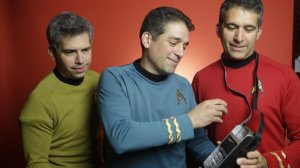This new device will likely to be disruptive to clinical laboratories, as it can noninvasively diagnose at least 16 diseases and conditions
Pathologists and clinical laboratory managers who are fans of Star Trek will be interested to learn that a real-life “Tricorder” medical diagnostic device may be just around the corner. Officials of the XPRIZE organization recently announced 10 finalists who are competing to build a working Tricorder capable of monitoring multiple vital signs and identifying specific disease states.
Erik Viirre, M.D., Ph.D., Technical and Medical Director for the Qualcomm Tricorder XPRIZE, announced the 10 finalists last fall. Their devices may have a disruptive impact on medical laboratories, particularly if they lead to inexpensive, self-diagnostic tools that are capable of immediately running most lab tests.
Launched in January 2012 by the XPRIZE Foundation, which organizes international competitions to advance innovation, this life sciences contest to make the tricorder a reality is offering $10 million (£6m) in prize money. (See Dark Daily, “Pathologists and Clinical Lab Scientists: Design a Modern “Tricorder” and You Could Win $10 Million From the XPRIZE Foundation!,” March 22, 2013.)
San Diego-based Qualcomm, a company that develops communications technologies, has pledged the prize money. This company has long viewed mobile technology in the hands of consumers as the key to reducing healthcare costs, according to a report published by the San Diego Tribune.
Final Round Will Score Devices Heavily on Ease of Use by Patients
The winning device must be wireless, portable, weigh less than five pounds (2.27 kg), and employ sensors and imaging technologies to let people measure five vital signs—blood pressure, heart rate, temperature, oxygen saturation and respiratory rate—as well as diagnose 13 core diseases, including diabetes, anemia, HIV, sleep apnea, pneumonia, and a choice of three elective conditions.
The Final Round of 10 finalists includes universities, medical device manufacturers, and tech start-ups. During the first half of 2015, judges will determine the three top entries. Prize money will be $7 million for first place, $2 million for second place, and $1 million for third place.
The winning Tricorder entries will be those achieving the highest diagnostics scores in a set of 15 distinct diseases in a group of 15 to 30 people over three days. Clinical laboratory professionals should take note of this fact: The diagnosis must be performed by consumers, independent of assistance by a healthcare worker or facility, according to the XPRIZE final round guidelines!
The final round of this competition will take place in San Diego. It is expected to involve nearly 500 consumer volunteers with health conditions ranging from diabetes to anemia to chronic obstructive pulmonary disease, noted the San Diego Tribune report. “They will take the tricorders home, and for a period of 72 hours, they will be using the tricorders,” said Grant Campany, Senior Director of the Tricorder XPRIZE. “This is a very complex process because it is almost like running 15 clinical trials,” he added.
Since the goal of this competition is to put mobile diagnostic technology in the hands of patients, 45% of scoring will be based on how easy they find the tricorders to use. The devices submitted by the three finalists also will be judged on accuracy, ability to detect all 15 of the specified diseases, connectivity, and other technical criteria.
‘Real-Life’ Tricorder Will not Look Like the Fictional Star Trek Device
But don’t expect the devices to resemble fictional Star Trek tricorders. Viirre, who is a neurologist and adjunct professor at the University of California, San Diego (UCSD), described finalists’ devices in a British Broadcasting Corporation (BBC) report as ranging from conventional smartphones with attachments to more “utilitarian-looking” devices that “get the job done.”
Final Frontier Medical Devices’ Entry is Completely Noninvasive

This fall, the Qualcomm TriCorder XPRIZE announced the ten finalists. Pictured left to right are three brothers of Team Final Frontier—one of the 10 finalists. The three brothers are George, Basil and Gus Harris. They were among the final contestants who visited San Diego to get instructions on the Final Round, which will test tricorder entries with real patients. The organizers held photo sessions with each of the 10 finalists dressed in Star Trek uniforms. (Copyright XPRIZE Foundation)
“What is really cool is our solution is completely noninvasive,” Basil Harris, M.D., told the San Diego Tribune. He is leader of the Final Frontier Medical Devices team, a Chicago emergency room physician, and has a doctorate degree in engineering.
The tricorder built by his team combines a regular tablet computer with a separate Bluetooth gadget that takes vitals and runs other tests. A companion tablet app walks patients through the same types of questions Harris asks every patient who comes into his ER, noted a story published on CNN.com.
“We are not pinching you in any way. We are trying to gather a lot of information in novel ways in the sensors that we are applying to the skin,” Harris explained. “We are using different wavelengths of light to gather information.”
DNA Medicine Institute’s Entry is Capable of Running Hundreds of Lab Values
The DNA Medicine Institute’s (DMI) entry, the Reusable Handheld Electrolyte and Lab Technology for Humans (rHEALTH) system is an all-in-one-box product. So far, rHEALTH, which recently took the $525,000 grand prize in the Nokia Sensing XCHALLENGE, has tests for 22 lab values. But this device is capable of doing hundreds−possibly thousands−of tests with a single drop of blood.

The DNA Medicine Institute’s Reusable Handheld Electrolyte and Lab Technology for Humans system (pictured above) is a contender in the Qualcomm Tricorder XPRIZE competition. (Photo copyright DNA Medicine Institute)
Tricorder May Be Used by Physicians to get Immediate Diagnostic Test Results
There’s no information yet on what any of the Tricorder devices that are in the finals of this contest would cost patients, but it may be more than most are willing to pay. A tricorder-type device, therefore, would more than likely be used by physicians−not healthcare consumers−to get immediate test results, eliminating the need to order clinical laboratory tests. This would obviously make it a competitor of clinical laboratories, by eliminating a significant number of lab test orders.
—Patricia Kirk
Related Information:
The Race to Create a Real-Life Tricorder
The Latest XPRIZE Winner Can Run Hundreds of Lab Tests With a Single Drop of Blood
MHealth Poised to Explode, Expert Says
DIY Healthcare: Consumer Self-Diagnosis and Treatment
Holy Spock! The Star Trek Medical Tricorder is Real, and it’s Only $150



